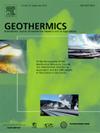Geothermal energy application for greenhouse microclimate management: A review
IF 3.5
2区 工程技术
Q3 ENERGY & FUELS
引用次数: 0
Abstract
Greenhouses offer an effective approach to enhance food production by extending growing seasons and optimizing plant conditions, yet their dependency on fossil fuels presents sustainability challenges. Geothermal energy provides a viable alternative for greenhouse climate control, with technologies utilizing both shallow and deep-ground resources to meet heating and cooling demands sustainably. This study comprehensively explores the applications and benefits of geothermal energy application in greenhouse climate management. It has been observed that deep geothermal sources present an efficient and eco-friendly solution, reducing fuel costs by up to 80%. Shallow systems, such as Earth-to-Air Heat Exchangers (EAHE), efficiently regulate temperatures in moderate climates while consuming only 8%–20% of the supplied thermal energy. Integrating EAHE with solar PV systems has shown potential for near self-sufficiency. For high-tech greenhouses, Ground Source Heat Pumps (GSHPs) achieve substantial energy savings (21%–40%) over traditional systems and reduce emissions by up to 50%. However, challenges persist, particularly with high capital cost and ground thermal imbalance. Finally, this study identifies key areas for future research, addressing these challenges to further geothermal technology development and close existing knowledge gaps, advancing sustainable greenhouse practices worldwide.

地热能在温室小气候管理中的应用综述
温室通过延长生长季节和优化植物条件,为提高粮食产量提供了有效途径,但其对化石燃料的依赖带来了可持续性挑战。地热能为温室气候控制提供了一种可行的替代方案,利用浅层和深层资源的技术可以可持续地满足供暖和制冷需求。本研究全面探讨了地热能在温室气候管理中的应用及效益。据观察,深层地热资源提供了一种高效环保的解决方案,可将燃料成本降低高达80%。浅层系统,如地对空热交换器(EAHE),在中等气候条件下有效调节温度,同时只消耗8%-20%的供应热能。将EAHE与太阳能光伏系统相结合已经显示出接近自给自足的潜力。对于高科技温室,地源热泵(GSHPs)比传统系统节省了大量能源(21%-40%),并减少了高达50%的二氧化碳排放。然而,挑战依然存在,特别是高投资成本和地面热不平衡。最后,本研究确定了未来研究的关键领域,解决这些挑战,进一步开发地热技术,缩小现有的知识差距,促进全球可持续温室实践。
本文章由计算机程序翻译,如有差异,请以英文原文为准。
求助全文
约1分钟内获得全文
求助全文
来源期刊

Geothermics
工程技术-地球科学综合
CiteScore
7.70
自引率
15.40%
发文量
237
审稿时长
4.5 months
期刊介绍:
Geothermics is an international journal devoted to the research and development of geothermal energy. The International Board of Editors of Geothermics, which comprises specialists in the various aspects of geothermal resources, exploration and development, guarantees the balanced, comprehensive view of scientific and technological developments in this promising energy field.
It promulgates the state of the art and science of geothermal energy, its exploration and exploitation through a regular exchange of information from all parts of the world. The journal publishes articles dealing with the theory, exploration techniques and all aspects of the utilization of geothermal resources. Geothermics serves as the scientific house, or exchange medium, through which the growing community of geothermal specialists can provide and receive information.
 求助内容:
求助内容: 应助结果提醒方式:
应助结果提醒方式:


